BSB51915 Diploma of Leadership and Management WHS Assignment
VerifiedAdded on 2021/06/15
|12
|4410
|41
Homework Assignment
AI Summary
This assignment, part of the BSB51915 Diploma of Leadership and Management, focuses on Work Health and Safety (WHS). It covers key aspects of WHS, including the risk management process with its five steps: establishing context, identifying risks, analyzing and evaluating risks, treating risks, and monitoring and reviewing risks. The assignment requires explaining various control measures such as elimination, substitution, isolation, engineering controls, and administrative controls. It also explores communication channels for reporting WHS breaches, emphasizing the significance of emergency procedures within organizations, using a restaurant scenario as an example. Finally, the assignment presents a practical application by detailing an eight-step procedure for employees to follow in the event of an office fire within a telecom organization, aligning with the WHS code of practice.
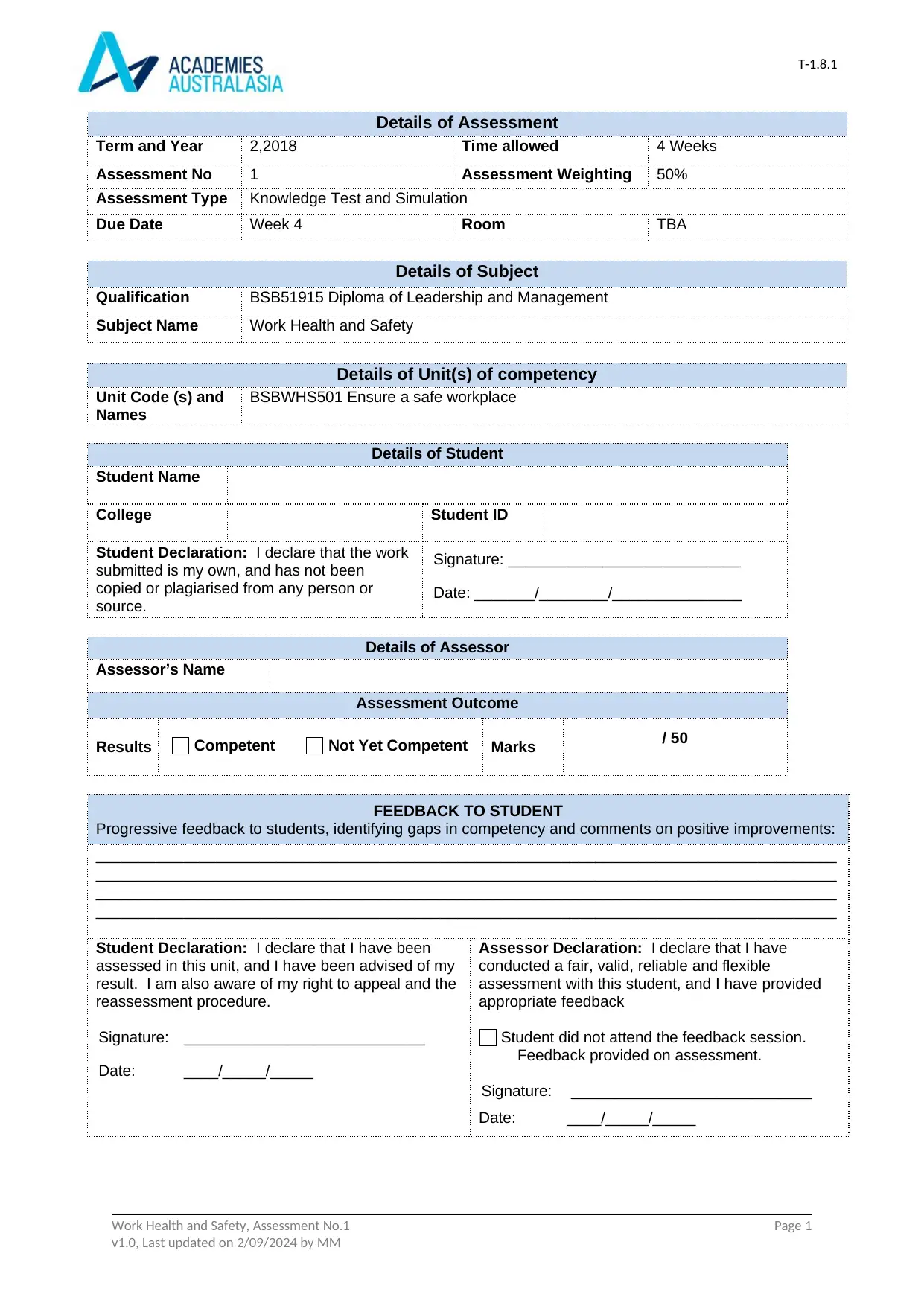
T-1.8.1
Details of Assessment
Term and Year 2,2018 Time allowed 4 Weeks
Assessment No 1 Assessment Weighting 50%
Assessment Type Knowledge Test and Simulation
Due Date Week 4 Room TBA
Details of Subject
Qualification BSB51915 Diploma of Leadership and Management
Subject Name Work Health and Safety
Details of Unit(s) of competency
Unit Code (s) and
Names
BSBWHS501 Ensure a safe workplace
Details of Student
Student Name
College Student ID
Student Declaration: I declare that the work
submitted is my own, and has not been
copied or plagiarised from any person or
source.
Signature: ___________________________
Date: _______/________/_______________
Details of Assessor
Assessor’s Name
Assessment Outcome
Results Competent Not Yet Competent Marks / 50
FEEDBACK TO STUDENT
Progressive feedback to students, identifying gaps in competency and comments on positive improvements:
______________________________________________________________________________________
______________________________________________________________________________________
______________________________________________________________________________________
______________________________________________________________________________________
Student Declaration: I declare that I have been
assessed in this unit, and I have been advised of my
result. I am also aware of my right to appeal and the
reassessment procedure.
Signature: ____________________________
Date: ____/_____/_____
Assessor Declaration: I declare that I have
conducted a fair, valid, reliable and flexible
assessment with this student, and I have provided
appropriate feedback
Student did not attend the feedback session.
Feedback provided on assessment.
Signature: ____________________________
Date: ____/_____/_____
Work Health and Safety, Assessment No.1 Page 1
v1.0, Last updated on 2/09/2024 by MM
Details of Assessment
Term and Year 2,2018 Time allowed 4 Weeks
Assessment No 1 Assessment Weighting 50%
Assessment Type Knowledge Test and Simulation
Due Date Week 4 Room TBA
Details of Subject
Qualification BSB51915 Diploma of Leadership and Management
Subject Name Work Health and Safety
Details of Unit(s) of competency
Unit Code (s) and
Names
BSBWHS501 Ensure a safe workplace
Details of Student
Student Name
College Student ID
Student Declaration: I declare that the work
submitted is my own, and has not been
copied or plagiarised from any person or
source.
Signature: ___________________________
Date: _______/________/_______________
Details of Assessor
Assessor’s Name
Assessment Outcome
Results Competent Not Yet Competent Marks / 50
FEEDBACK TO STUDENT
Progressive feedback to students, identifying gaps in competency and comments on positive improvements:
______________________________________________________________________________________
______________________________________________________________________________________
______________________________________________________________________________________
______________________________________________________________________________________
Student Declaration: I declare that I have been
assessed in this unit, and I have been advised of my
result. I am also aware of my right to appeal and the
reassessment procedure.
Signature: ____________________________
Date: ____/_____/_____
Assessor Declaration: I declare that I have
conducted a fair, valid, reliable and flexible
assessment with this student, and I have provided
appropriate feedback
Student did not attend the feedback session.
Feedback provided on assessment.
Signature: ____________________________
Date: ____/_____/_____
Work Health and Safety, Assessment No.1 Page 1
v1.0, Last updated on 2/09/2024 by MM
Paraphrase This Document
Need a fresh take? Get an instant paraphrase of this document with our AI Paraphraser
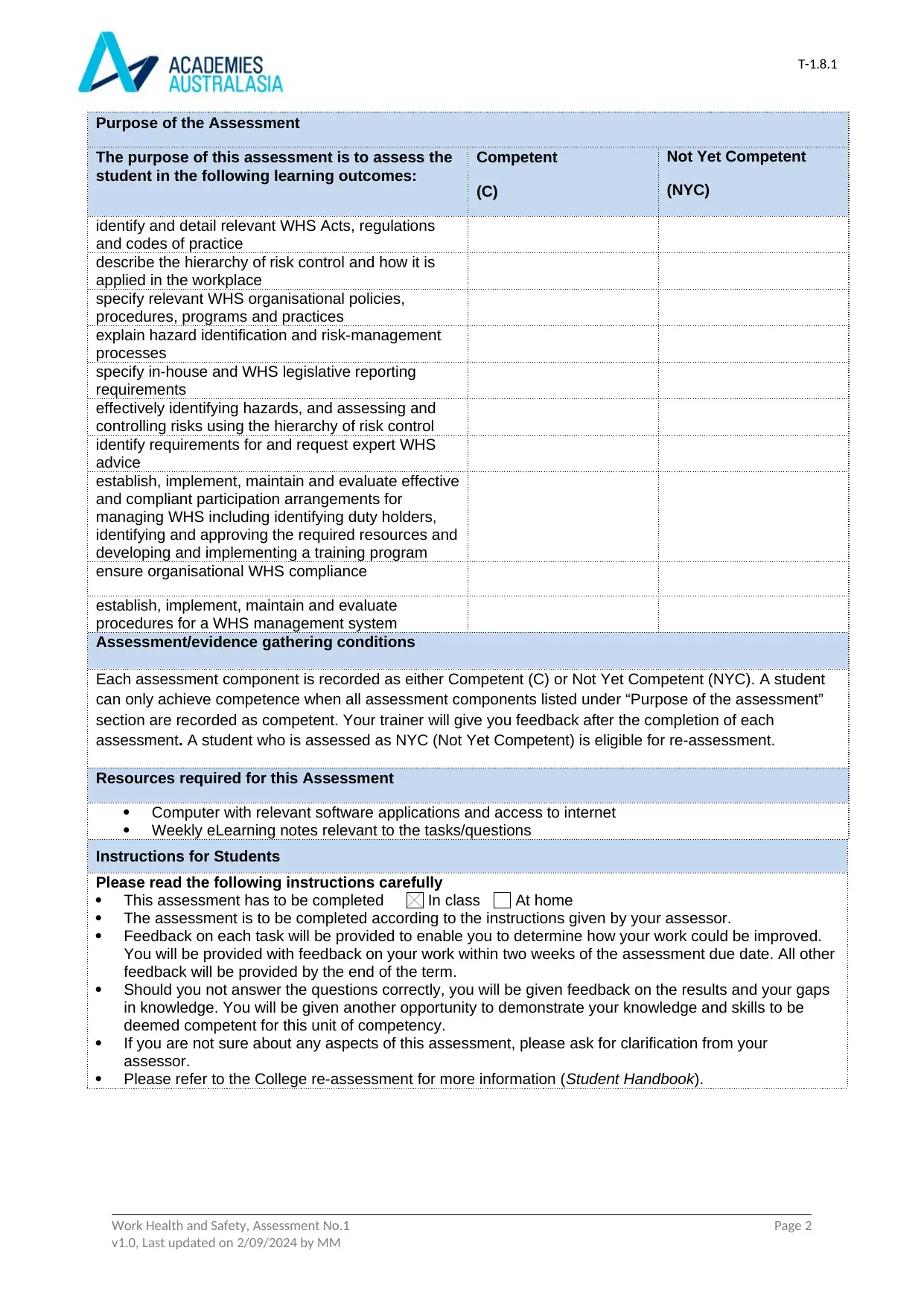
T-1.8.1
Purpose of the Assessment
The purpose of this assessment is to assess the
student in the following learning outcomes:
Competent
(C)
Not Yet Competent
(NYC)
identify and detail relevant WHS Acts, regulations
and codes of practice
describe the hierarchy of risk control and how it is
applied in the workplace
specify relevant WHS organisational policies,
procedures, programs and practices
explain hazard identification and risk-management
processes
specify in-house and WHS legislative reporting
requirements
effectively identifying hazards, and assessing and
controlling risks using the hierarchy of risk control
identify requirements for and request expert WHS
advice
establish, implement, maintain and evaluate effective
and compliant participation arrangements for
managing WHS including identifying duty holders,
identifying and approving the required resources and
developing and implementing a training program
ensure organisational WHS compliance
establish, implement, maintain and evaluate
procedures for a WHS management system
Assessment/evidence gathering conditions
Each assessment component is recorded as either Competent (C) or Not Yet Competent (NYC). A student
can only achieve competence when all assessment components listed under “Purpose of the assessment”
section are recorded as competent. Your trainer will give you feedback after the completion of each
assessment. A student who is assessed as NYC (Not Yet Competent) is eligible for re-assessment.
Resources required for this Assessment
Computer with relevant software applications and access to internet
Weekly eLearning notes relevant to the tasks/questions
Instructions for Students
Please read the following instructions carefully
This assessment has to be completed In class At home
The assessment is to be completed according to the instructions given by your assessor.
Feedback on each task will be provided to enable you to determine how your work could be improved.
You will be provided with feedback on your work within two weeks of the assessment due date. All other
feedback will be provided by the end of the term.
Should you not answer the questions correctly, you will be given feedback on the results and your gaps
in knowledge. You will be given another opportunity to demonstrate your knowledge and skills to be
deemed competent for this unit of competency.
If you are not sure about any aspects of this assessment, please ask for clarification from your
assessor.
Please refer to the College re-assessment for more information (Student Handbook).
Work Health and Safety, Assessment No.1 Page 2
v1.0, Last updated on 2/09/2024 by MM
Purpose of the Assessment
The purpose of this assessment is to assess the
student in the following learning outcomes:
Competent
(C)
Not Yet Competent
(NYC)
identify and detail relevant WHS Acts, regulations
and codes of practice
describe the hierarchy of risk control and how it is
applied in the workplace
specify relevant WHS organisational policies,
procedures, programs and practices
explain hazard identification and risk-management
processes
specify in-house and WHS legislative reporting
requirements
effectively identifying hazards, and assessing and
controlling risks using the hierarchy of risk control
identify requirements for and request expert WHS
advice
establish, implement, maintain and evaluate effective
and compliant participation arrangements for
managing WHS including identifying duty holders,
identifying and approving the required resources and
developing and implementing a training program
ensure organisational WHS compliance
establish, implement, maintain and evaluate
procedures for a WHS management system
Assessment/evidence gathering conditions
Each assessment component is recorded as either Competent (C) or Not Yet Competent (NYC). A student
can only achieve competence when all assessment components listed under “Purpose of the assessment”
section are recorded as competent. Your trainer will give you feedback after the completion of each
assessment. A student who is assessed as NYC (Not Yet Competent) is eligible for re-assessment.
Resources required for this Assessment
Computer with relevant software applications and access to internet
Weekly eLearning notes relevant to the tasks/questions
Instructions for Students
Please read the following instructions carefully
This assessment has to be completed In class At home
The assessment is to be completed according to the instructions given by your assessor.
Feedback on each task will be provided to enable you to determine how your work could be improved.
You will be provided with feedback on your work within two weeks of the assessment due date. All other
feedback will be provided by the end of the term.
Should you not answer the questions correctly, you will be given feedback on the results and your gaps
in knowledge. You will be given another opportunity to demonstrate your knowledge and skills to be
deemed competent for this unit of competency.
If you are not sure about any aspects of this assessment, please ask for clarification from your
assessor.
Please refer to the College re-assessment for more information (Student Handbook).
Work Health and Safety, Assessment No.1 Page 2
v1.0, Last updated on 2/09/2024 by MM
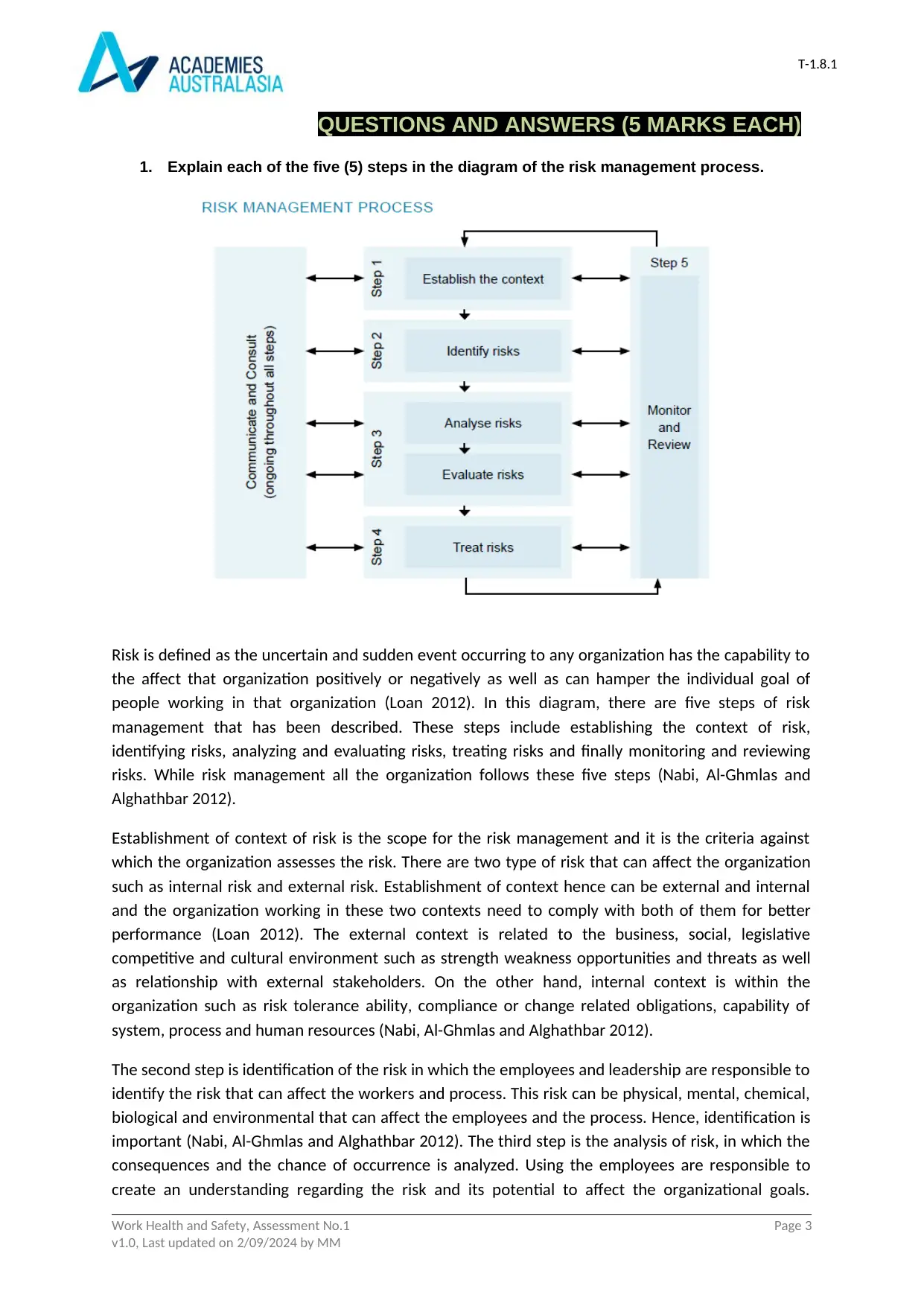
T-1.8.1
QUESTIONS AND ANSWERS (5 MARKS EACH)
1. Explain each of the five (5) steps in the diagram of the risk management process.
Risk is defined as the uncertain and sudden event occurring to any organization has the capability to
the affect that organization positively or negatively as well as can hamper the individual goal of
people working in that organization (Loan 2012). In this diagram, there are five steps of risk
management that has been described. These steps include establishing the context of risk,
identifying risks, analyzing and evaluating risks, treating risks and finally monitoring and reviewing
risks. While risk management all the organization follows these five steps (Nabi, Al-Ghmlas and
Alghathbar 2012).
Establishment of context of risk is the scope for the risk management and it is the criteria against
which the organization assesses the risk. There are two type of risk that can affect the organization
such as internal risk and external risk. Establishment of context hence can be external and internal
and the organization working in these two contexts need to comply with both of them for better
performance (Loan 2012). The external context is related to the business, social, legislative
competitive and cultural environment such as strength weakness opportunities and threats as well
as relationship with external stakeholders. On the other hand, internal context is within the
organization such as risk tolerance ability, compliance or change related obligations, capability of
system, process and human resources (Nabi, Al-Ghmlas and Alghathbar 2012).
The second step is identification of the risk in which the employees and leadership are responsible to
identify the risk that can affect the workers and process. This risk can be physical, mental, chemical,
biological and environmental that can affect the employees and the process. Hence, identification is
important (Nabi, Al-Ghmlas and Alghathbar 2012). The third step is the analysis of risk, in which the
consequences and the chance of occurrence is analyzed. Using the employees are responsible to
create an understanding regarding the risk and its potential to affect the organizational goals.
Work Health and Safety, Assessment No.1 Page 3
v1.0, Last updated on 2/09/2024 by MM
QUESTIONS AND ANSWERS (5 MARKS EACH)
1. Explain each of the five (5) steps in the diagram of the risk management process.
Risk is defined as the uncertain and sudden event occurring to any organization has the capability to
the affect that organization positively or negatively as well as can hamper the individual goal of
people working in that organization (Loan 2012). In this diagram, there are five steps of risk
management that has been described. These steps include establishing the context of risk,
identifying risks, analyzing and evaluating risks, treating risks and finally monitoring and reviewing
risks. While risk management all the organization follows these five steps (Nabi, Al-Ghmlas and
Alghathbar 2012).
Establishment of context of risk is the scope for the risk management and it is the criteria against
which the organization assesses the risk. There are two type of risk that can affect the organization
such as internal risk and external risk. Establishment of context hence can be external and internal
and the organization working in these two contexts need to comply with both of them for better
performance (Loan 2012). The external context is related to the business, social, legislative
competitive and cultural environment such as strength weakness opportunities and threats as well
as relationship with external stakeholders. On the other hand, internal context is within the
organization such as risk tolerance ability, compliance or change related obligations, capability of
system, process and human resources (Nabi, Al-Ghmlas and Alghathbar 2012).
The second step is identification of the risk in which the employees and leadership are responsible to
identify the risk that can affect the workers and process. This risk can be physical, mental, chemical,
biological and environmental that can affect the employees and the process. Hence, identification is
important (Nabi, Al-Ghmlas and Alghathbar 2012). The third step is the analysis of risk, in which the
consequences and the chance of occurrence is analyzed. Using the employees are responsible to
create an understanding regarding the risk and its potential to affect the organizational goals.
Work Health and Safety, Assessment No.1 Page 3
v1.0, Last updated on 2/09/2024 by MM
⊘ This is a preview!⊘
Do you want full access?
Subscribe today to unlock all pages.

Trusted by 1+ million students worldwide
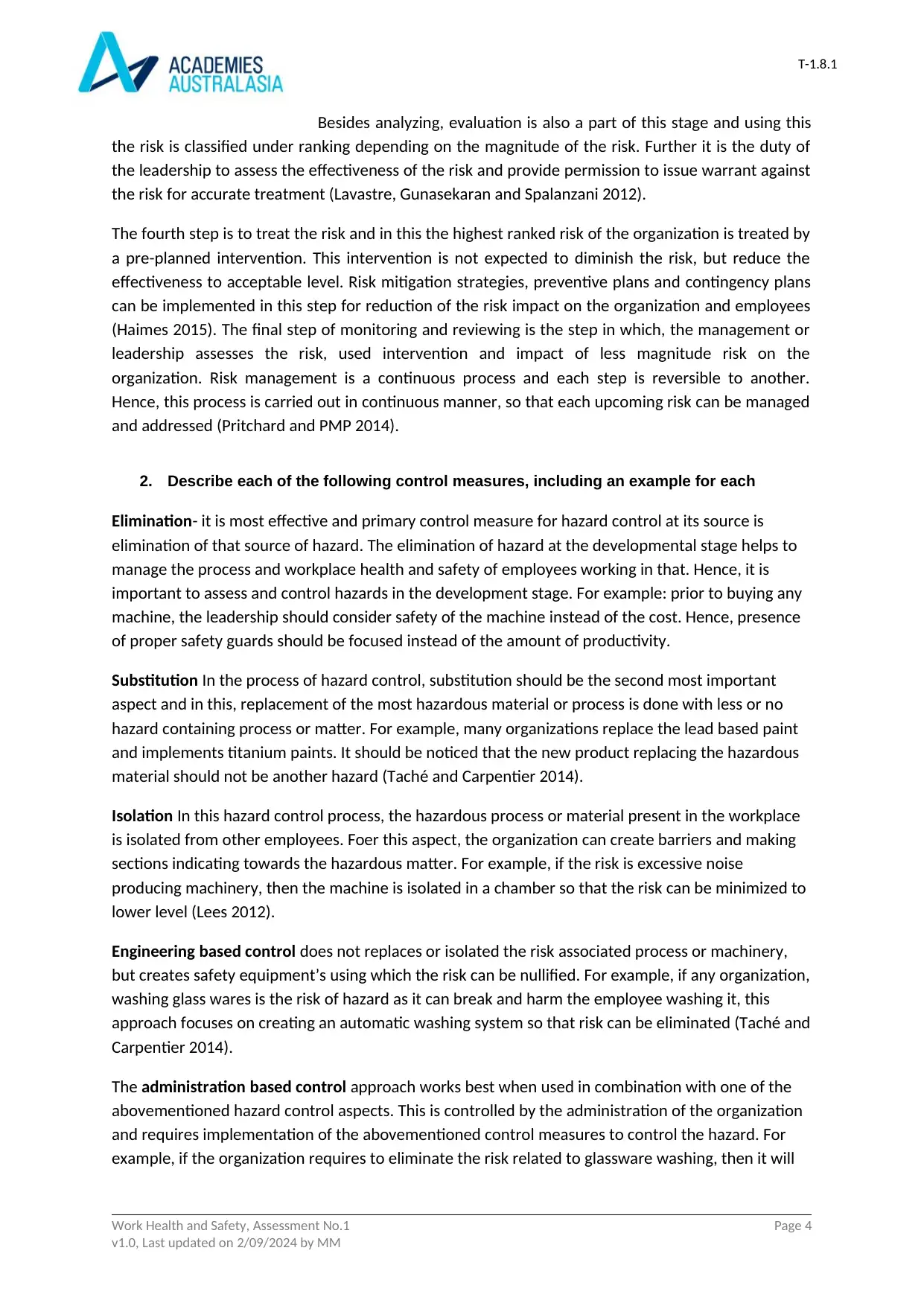
T-1.8.1
Besides analyzing, evaluation is also a part of this stage and using this
the risk is classified under ranking depending on the magnitude of the risk. Further it is the duty of
the leadership to assess the effectiveness of the risk and provide permission to issue warrant against
the risk for accurate treatment (Lavastre, Gunasekaran and Spalanzani 2012).
The fourth step is to treat the risk and in this the highest ranked risk of the organization is treated by
a pre-planned intervention. This intervention is not expected to diminish the risk, but reduce the
effectiveness to acceptable level. Risk mitigation strategies, preventive plans and contingency plans
can be implemented in this step for reduction of the risk impact on the organization and employees
(Haimes 2015). The final step of monitoring and reviewing is the step in which, the management or
leadership assesses the risk, used intervention and impact of less magnitude risk on the
organization. Risk management is a continuous process and each step is reversible to another.
Hence, this process is carried out in continuous manner, so that each upcoming risk can be managed
and addressed (Pritchard and PMP 2014).
2. Describe each of the following control measures, including an example for each
Elimination- it is most effective and primary control measure for hazard control at its source is
elimination of that source of hazard. The elimination of hazard at the developmental stage helps to
manage the process and workplace health and safety of employees working in that. Hence, it is
important to assess and control hazards in the development stage. For example: prior to buying any
machine, the leadership should consider safety of the machine instead of the cost. Hence, presence
of proper safety guards should be focused instead of the amount of productivity.
Substitution In the process of hazard control, substitution should be the second most important
aspect and in this, replacement of the most hazardous material or process is done with less or no
hazard containing process or matter. For example, many organizations replace the lead based paint
and implements titanium paints. It should be noticed that the new product replacing the hazardous
material should not be another hazard (Taché and Carpentier 2014).
Isolation In this hazard control process, the hazardous process or material present in the workplace
is isolated from other employees. Foer this aspect, the organization can create barriers and making
sections indicating towards the hazardous matter. For example, if the risk is excessive noise
producing machinery, then the machine is isolated in a chamber so that the risk can be minimized to
lower level (Lees 2012).
Engineering based control does not replaces or isolated the risk associated process or machinery,
but creates safety equipment’s using which the risk can be nullified. For example, if any organization,
washing glass wares is the risk of hazard as it can break and harm the employee washing it, this
approach focuses on creating an automatic washing system so that risk can be eliminated (Taché and
Carpentier 2014).
The administration based control approach works best when used in combination with one of the
abovementioned hazard control aspects. This is controlled by the administration of the organization
and requires implementation of the abovementioned control measures to control the hazard. For
example, if the organization requires to eliminate the risk related to glassware washing, then it will
Work Health and Safety, Assessment No.1 Page 4
v1.0, Last updated on 2/09/2024 by MM
Besides analyzing, evaluation is also a part of this stage and using this
the risk is classified under ranking depending on the magnitude of the risk. Further it is the duty of
the leadership to assess the effectiveness of the risk and provide permission to issue warrant against
the risk for accurate treatment (Lavastre, Gunasekaran and Spalanzani 2012).
The fourth step is to treat the risk and in this the highest ranked risk of the organization is treated by
a pre-planned intervention. This intervention is not expected to diminish the risk, but reduce the
effectiveness to acceptable level. Risk mitigation strategies, preventive plans and contingency plans
can be implemented in this step for reduction of the risk impact on the organization and employees
(Haimes 2015). The final step of monitoring and reviewing is the step in which, the management or
leadership assesses the risk, used intervention and impact of less magnitude risk on the
organization. Risk management is a continuous process and each step is reversible to another.
Hence, this process is carried out in continuous manner, so that each upcoming risk can be managed
and addressed (Pritchard and PMP 2014).
2. Describe each of the following control measures, including an example for each
Elimination- it is most effective and primary control measure for hazard control at its source is
elimination of that source of hazard. The elimination of hazard at the developmental stage helps to
manage the process and workplace health and safety of employees working in that. Hence, it is
important to assess and control hazards in the development stage. For example: prior to buying any
machine, the leadership should consider safety of the machine instead of the cost. Hence, presence
of proper safety guards should be focused instead of the amount of productivity.
Substitution In the process of hazard control, substitution should be the second most important
aspect and in this, replacement of the most hazardous material or process is done with less or no
hazard containing process or matter. For example, many organizations replace the lead based paint
and implements titanium paints. It should be noticed that the new product replacing the hazardous
material should not be another hazard (Taché and Carpentier 2014).
Isolation In this hazard control process, the hazardous process or material present in the workplace
is isolated from other employees. Foer this aspect, the organization can create barriers and making
sections indicating towards the hazardous matter. For example, if the risk is excessive noise
producing machinery, then the machine is isolated in a chamber so that the risk can be minimized to
lower level (Lees 2012).
Engineering based control does not replaces or isolated the risk associated process or machinery,
but creates safety equipment’s using which the risk can be nullified. For example, if any organization,
washing glass wares is the risk of hazard as it can break and harm the employee washing it, this
approach focuses on creating an automatic washing system so that risk can be eliminated (Taché and
Carpentier 2014).
The administration based control approach works best when used in combination with one of the
abovementioned hazard control aspects. This is controlled by the administration of the organization
and requires implementation of the abovementioned control measures to control the hazard. For
example, if the organization requires to eliminate the risk related to glassware washing, then it will
Work Health and Safety, Assessment No.1 Page 4
v1.0, Last updated on 2/09/2024 by MM
Paraphrase This Document
Need a fresh take? Get an instant paraphrase of this document with our AI Paraphraser
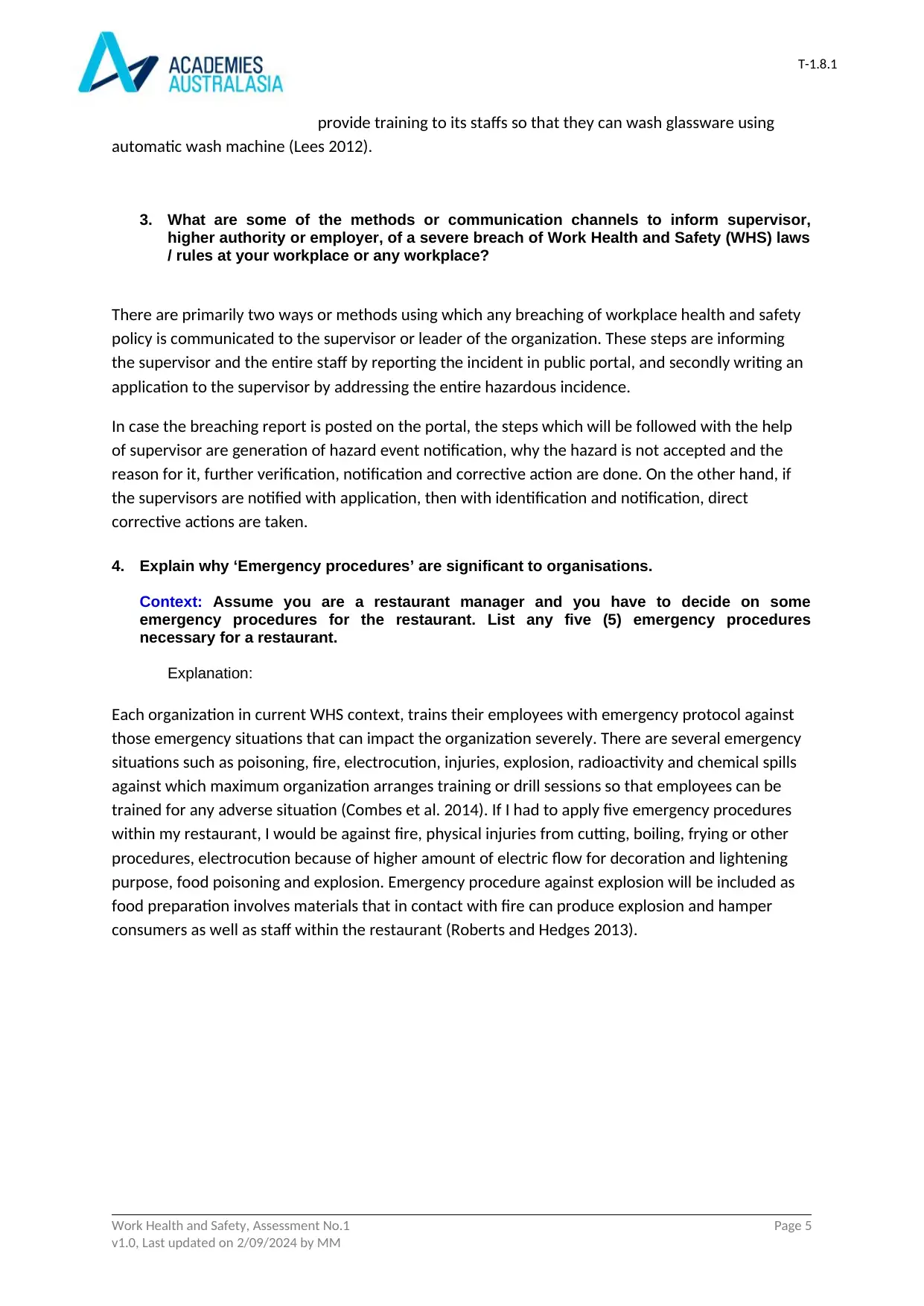
T-1.8.1
provide training to its staffs so that they can wash glassware using
automatic wash machine (Lees 2012).
3. What are some of the methods or communication channels to inform supervisor,
higher authority or employer, of a severe breach of Work Health and Safety (WHS) laws
/ rules at your workplace or any workplace?
There are primarily two ways or methods using which any breaching of workplace health and safety
policy is communicated to the supervisor or leader of the organization. These steps are informing
the supervisor and the entire staff by reporting the incident in public portal, and secondly writing an
application to the supervisor by addressing the entire hazardous incidence.
In case the breaching report is posted on the portal, the steps which will be followed with the help
of supervisor are generation of hazard event notification, why the hazard is not accepted and the
reason for it, further verification, notification and corrective action are done. On the other hand, if
the supervisors are notified with application, then with identification and notification, direct
corrective actions are taken.
4. Explain why ‘Emergency procedures’ are significant to organisations.
Context: Assume you are a restaurant manager and you have to decide on some
emergency procedures for the restaurant. List any five (5) emergency procedures
necessary for a restaurant.
Explanation:
Each organization in current WHS context, trains their employees with emergency protocol against
those emergency situations that can impact the organization severely. There are several emergency
situations such as poisoning, fire, electrocution, injuries, explosion, radioactivity and chemical spills
against which maximum organization arranges training or drill sessions so that employees can be
trained for any adverse situation (Combes et al. 2014). If I had to apply five emergency procedures
within my restaurant, I would be against fire, physical injuries from cutting, boiling, frying or other
procedures, electrocution because of higher amount of electric flow for decoration and lightening
purpose, food poisoning and explosion. Emergency procedure against explosion will be included as
food preparation involves materials that in contact with fire can produce explosion and hamper
consumers as well as staff within the restaurant (Roberts and Hedges 2013).
Work Health and Safety, Assessment No.1 Page 5
v1.0, Last updated on 2/09/2024 by MM
provide training to its staffs so that they can wash glassware using
automatic wash machine (Lees 2012).
3. What are some of the methods or communication channels to inform supervisor,
higher authority or employer, of a severe breach of Work Health and Safety (WHS) laws
/ rules at your workplace or any workplace?
There are primarily two ways or methods using which any breaching of workplace health and safety
policy is communicated to the supervisor or leader of the organization. These steps are informing
the supervisor and the entire staff by reporting the incident in public portal, and secondly writing an
application to the supervisor by addressing the entire hazardous incidence.
In case the breaching report is posted on the portal, the steps which will be followed with the help
of supervisor are generation of hazard event notification, why the hazard is not accepted and the
reason for it, further verification, notification and corrective action are done. On the other hand, if
the supervisors are notified with application, then with identification and notification, direct
corrective actions are taken.
4. Explain why ‘Emergency procedures’ are significant to organisations.
Context: Assume you are a restaurant manager and you have to decide on some
emergency procedures for the restaurant. List any five (5) emergency procedures
necessary for a restaurant.
Explanation:
Each organization in current WHS context, trains their employees with emergency protocol against
those emergency situations that can impact the organization severely. There are several emergency
situations such as poisoning, fire, electrocution, injuries, explosion, radioactivity and chemical spills
against which maximum organization arranges training or drill sessions so that employees can be
trained for any adverse situation (Combes et al. 2014). If I had to apply five emergency procedures
within my restaurant, I would be against fire, physical injuries from cutting, boiling, frying or other
procedures, electrocution because of higher amount of electric flow for decoration and lightening
purpose, food poisoning and explosion. Emergency procedure against explosion will be included as
food preparation involves materials that in contact with fire can produce explosion and hamper
consumers as well as staff within the restaurant (Roberts and Hedges 2013).
Work Health and Safety, Assessment No.1 Page 5
v1.0, Last updated on 2/09/2024 by MM
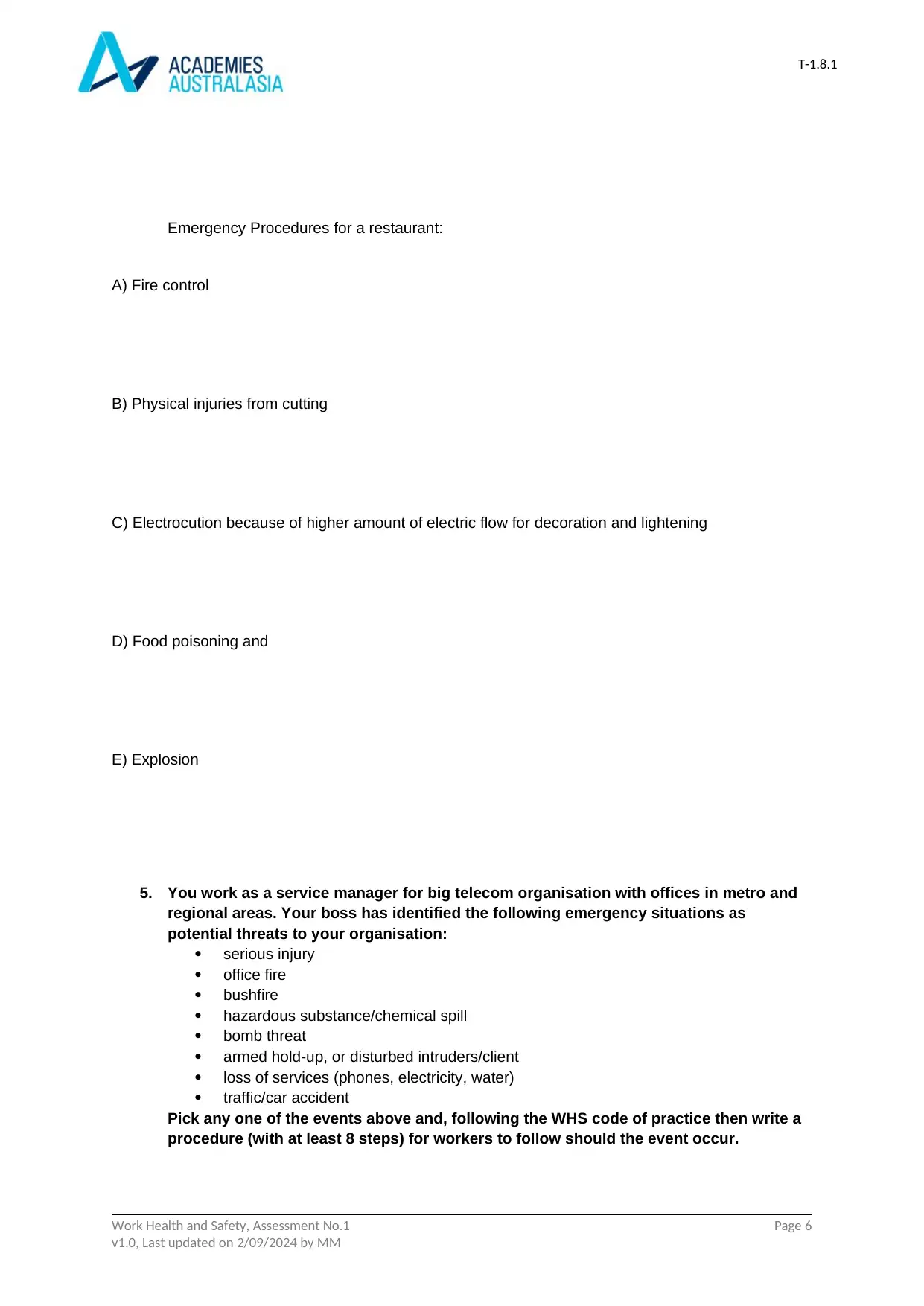
T-1.8.1
Emergency Procedures for a restaurant:
A) Fire control
B) Physical injuries from cutting
C) Electrocution because of higher amount of electric flow for decoration and lightening
D) Food poisoning and
E) Explosion
5. You work as a service manager for big telecom organisation with offices in metro and
regional areas. Your boss has identified the following emergency situations as
potential threats to your organisation:
serious injury
office fire
bushfire
hazardous substance/chemical spill
bomb threat
armed hold-up, or disturbed intruders/client
loss of services (phones, electricity, water)
traffic/car accident
Pick any one of the events above and, following the WHS code of practice then write a
procedure (with at least 8 steps) for workers to follow should the event occur.
Work Health and Safety, Assessment No.1 Page 6
v1.0, Last updated on 2/09/2024 by MM
Emergency Procedures for a restaurant:
A) Fire control
B) Physical injuries from cutting
C) Electrocution because of higher amount of electric flow for decoration and lightening
D) Food poisoning and
E) Explosion
5. You work as a service manager for big telecom organisation with offices in metro and
regional areas. Your boss has identified the following emergency situations as
potential threats to your organisation:
serious injury
office fire
bushfire
hazardous substance/chemical spill
bomb threat
armed hold-up, or disturbed intruders/client
loss of services (phones, electricity, water)
traffic/car accident
Pick any one of the events above and, following the WHS code of practice then write a
procedure (with at least 8 steps) for workers to follow should the event occur.
Work Health and Safety, Assessment No.1 Page 6
v1.0, Last updated on 2/09/2024 by MM
⊘ This is a preview!⊘
Do you want full access?
Subscribe today to unlock all pages.

Trusted by 1+ million students worldwide
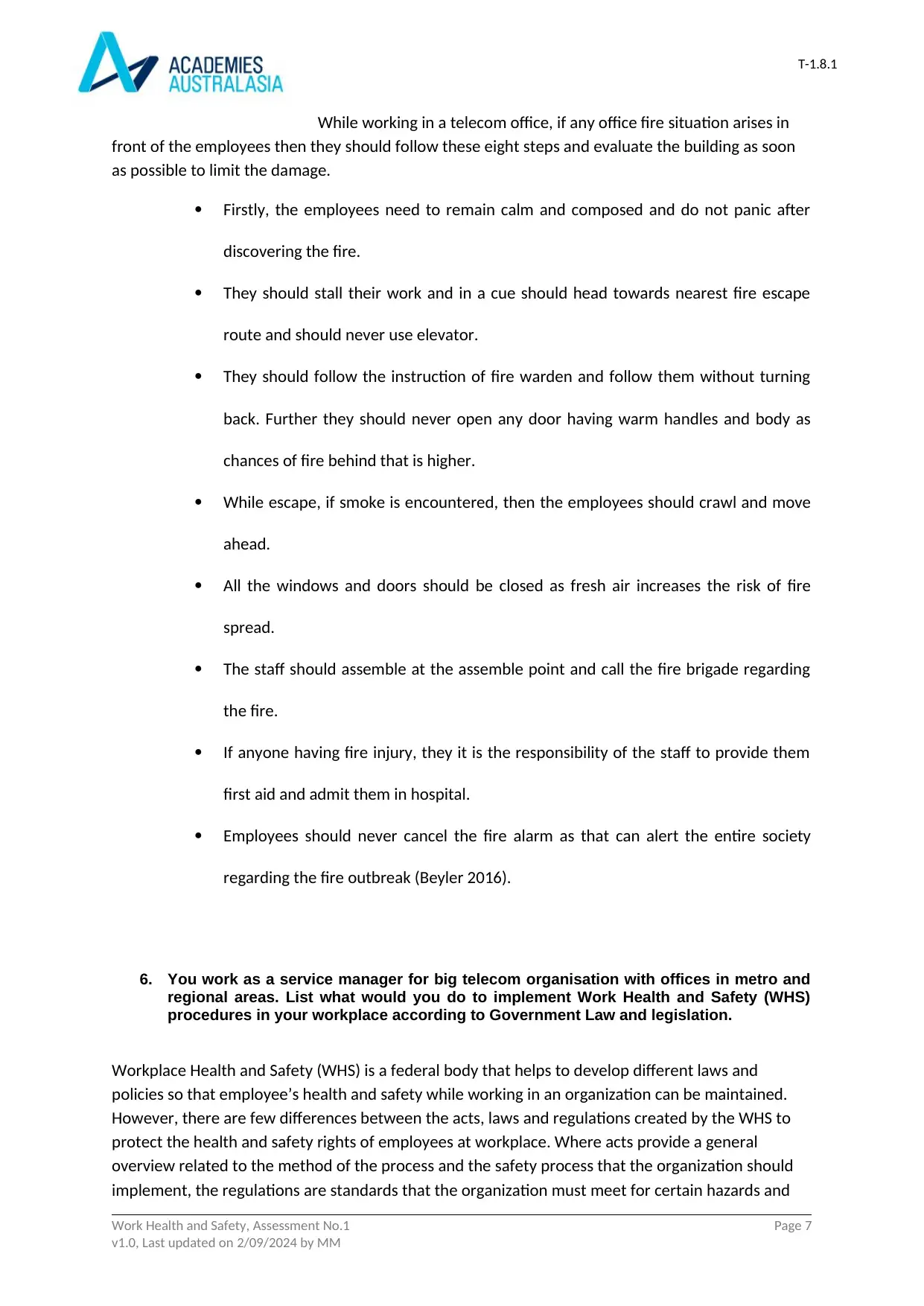
T-1.8.1
While working in a telecom office, if any office fire situation arises in
front of the employees then they should follow these eight steps and evaluate the building as soon
as possible to limit the damage.
Firstly, the employees need to remain calm and composed and do not panic after
discovering the fire.
They should stall their work and in a cue should head towards nearest fire escape
route and should never use elevator.
They should follow the instruction of fire warden and follow them without turning
back. Further they should never open any door having warm handles and body as
chances of fire behind that is higher.
While escape, if smoke is encountered, then the employees should crawl and move
ahead.
All the windows and doors should be closed as fresh air increases the risk of fire
spread.
The staff should assemble at the assemble point and call the fire brigade regarding
the fire.
If anyone having fire injury, they it is the responsibility of the staff to provide them
first aid and admit them in hospital.
Employees should never cancel the fire alarm as that can alert the entire society
regarding the fire outbreak (Beyler 2016).
6. You work as a service manager for big telecom organisation with offices in metro and
regional areas. List what would you do to implement Work Health and Safety (WHS)
procedures in your workplace according to Government Law and legislation.
Workplace Health and Safety (WHS) is a federal body that helps to develop different laws and
policies so that employee’s health and safety while working in an organization can be maintained.
However, there are few differences between the acts, laws and regulations created by the WHS to
protect the health and safety rights of employees at workplace. Where acts provide a general
overview related to the method of the process and the safety process that the organization should
implement, the regulations are standards that the organization must meet for certain hazards and
Work Health and Safety, Assessment No.1 Page 7
v1.0, Last updated on 2/09/2024 by MM
While working in a telecom office, if any office fire situation arises in
front of the employees then they should follow these eight steps and evaluate the building as soon
as possible to limit the damage.
Firstly, the employees need to remain calm and composed and do not panic after
discovering the fire.
They should stall their work and in a cue should head towards nearest fire escape
route and should never use elevator.
They should follow the instruction of fire warden and follow them without turning
back. Further they should never open any door having warm handles and body as
chances of fire behind that is higher.
While escape, if smoke is encountered, then the employees should crawl and move
ahead.
All the windows and doors should be closed as fresh air increases the risk of fire
spread.
The staff should assemble at the assemble point and call the fire brigade regarding
the fire.
If anyone having fire injury, they it is the responsibility of the staff to provide them
first aid and admit them in hospital.
Employees should never cancel the fire alarm as that can alert the entire society
regarding the fire outbreak (Beyler 2016).
6. You work as a service manager for big telecom organisation with offices in metro and
regional areas. List what would you do to implement Work Health and Safety (WHS)
procedures in your workplace according to Government Law and legislation.
Workplace Health and Safety (WHS) is a federal body that helps to develop different laws and
policies so that employee’s health and safety while working in an organization can be maintained.
However, there are few differences between the acts, laws and regulations created by the WHS to
protect the health and safety rights of employees at workplace. Where acts provide a general
overview related to the method of the process and the safety process that the organization should
implement, the regulations are standards that the organization must meet for certain hazards and
Work Health and Safety, Assessment No.1 Page 7
v1.0, Last updated on 2/09/2024 by MM
Paraphrase This Document
Need a fresh take? Get an instant paraphrase of this document with our AI Paraphraser
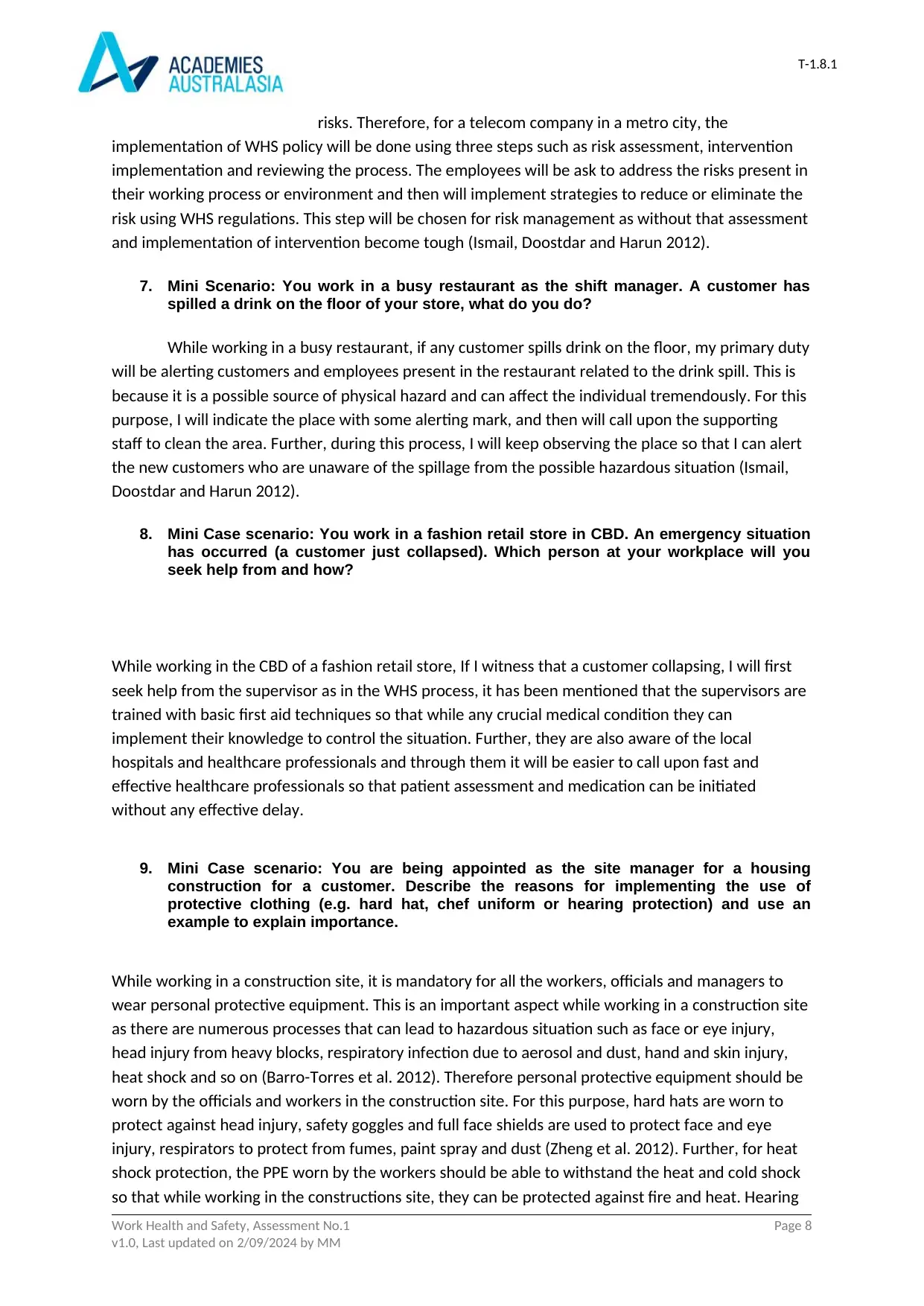
T-1.8.1
risks. Therefore, for a telecom company in a metro city, the
implementation of WHS policy will be done using three steps such as risk assessment, intervention
implementation and reviewing the process. The employees will be ask to address the risks present in
their working process or environment and then will implement strategies to reduce or eliminate the
risk using WHS regulations. This step will be chosen for risk management as without that assessment
and implementation of intervention become tough (Ismail, Doostdar and Harun 2012).
7. Mini Scenario: You work in a busy restaurant as the shift manager. A customer has
spilled a drink on the floor of your store, what do you do?
While working in a busy restaurant, if any customer spills drink on the floor, my primary duty
will be alerting customers and employees present in the restaurant related to the drink spill. This is
because it is a possible source of physical hazard and can affect the individual tremendously. For this
purpose, I will indicate the place with some alerting mark, and then will call upon the supporting
staff to clean the area. Further, during this process, I will keep observing the place so that I can alert
the new customers who are unaware of the spillage from the possible hazardous situation (Ismail,
Doostdar and Harun 2012).
8. Mini Case scenario: You work in a fashion retail store in CBD. An emergency situation
has occurred (a customer just collapsed). Which person at your workplace will you
seek help from and how?
While working in the CBD of a fashion retail store, If I witness that a customer collapsing, I will first
seek help from the supervisor as in the WHS process, it has been mentioned that the supervisors are
trained with basic first aid techniques so that while any crucial medical condition they can
implement their knowledge to control the situation. Further, they are also aware of the local
hospitals and healthcare professionals and through them it will be easier to call upon fast and
effective healthcare professionals so that patient assessment and medication can be initiated
without any effective delay.
9. Mini Case scenario: You are being appointed as the site manager for a housing
construction for a customer. Describe the reasons for implementing the use of
protective clothing (e.g. hard hat, chef uniform or hearing protection) and use an
example to explain importance.
While working in a construction site, it is mandatory for all the workers, officials and managers to
wear personal protective equipment. This is an important aspect while working in a construction site
as there are numerous processes that can lead to hazardous situation such as face or eye injury,
head injury from heavy blocks, respiratory infection due to aerosol and dust, hand and skin injury,
heat shock and so on (Barro-Torres et al. 2012). Therefore personal protective equipment should be
worn by the officials and workers in the construction site. For this purpose, hard hats are worn to
protect against head injury, safety goggles and full face shields are used to protect face and eye
injury, respirators to protect from fumes, paint spray and dust (Zheng et al. 2012). Further, for heat
shock protection, the PPE worn by the workers should be able to withstand the heat and cold shock
so that while working in the constructions site, they can be protected against fire and heat. Hearing
Work Health and Safety, Assessment No.1 Page 8
v1.0, Last updated on 2/09/2024 by MM
risks. Therefore, for a telecom company in a metro city, the
implementation of WHS policy will be done using three steps such as risk assessment, intervention
implementation and reviewing the process. The employees will be ask to address the risks present in
their working process or environment and then will implement strategies to reduce or eliminate the
risk using WHS regulations. This step will be chosen for risk management as without that assessment
and implementation of intervention become tough (Ismail, Doostdar and Harun 2012).
7. Mini Scenario: You work in a busy restaurant as the shift manager. A customer has
spilled a drink on the floor of your store, what do you do?
While working in a busy restaurant, if any customer spills drink on the floor, my primary duty
will be alerting customers and employees present in the restaurant related to the drink spill. This is
because it is a possible source of physical hazard and can affect the individual tremendously. For this
purpose, I will indicate the place with some alerting mark, and then will call upon the supporting
staff to clean the area. Further, during this process, I will keep observing the place so that I can alert
the new customers who are unaware of the spillage from the possible hazardous situation (Ismail,
Doostdar and Harun 2012).
8. Mini Case scenario: You work in a fashion retail store in CBD. An emergency situation
has occurred (a customer just collapsed). Which person at your workplace will you
seek help from and how?
While working in the CBD of a fashion retail store, If I witness that a customer collapsing, I will first
seek help from the supervisor as in the WHS process, it has been mentioned that the supervisors are
trained with basic first aid techniques so that while any crucial medical condition they can
implement their knowledge to control the situation. Further, they are also aware of the local
hospitals and healthcare professionals and through them it will be easier to call upon fast and
effective healthcare professionals so that patient assessment and medication can be initiated
without any effective delay.
9. Mini Case scenario: You are being appointed as the site manager for a housing
construction for a customer. Describe the reasons for implementing the use of
protective clothing (e.g. hard hat, chef uniform or hearing protection) and use an
example to explain importance.
While working in a construction site, it is mandatory for all the workers, officials and managers to
wear personal protective equipment. This is an important aspect while working in a construction site
as there are numerous processes that can lead to hazardous situation such as face or eye injury,
head injury from heavy blocks, respiratory infection due to aerosol and dust, hand and skin injury,
heat shock and so on (Barro-Torres et al. 2012). Therefore personal protective equipment should be
worn by the officials and workers in the construction site. For this purpose, hard hats are worn to
protect against head injury, safety goggles and full face shields are used to protect face and eye
injury, respirators to protect from fumes, paint spray and dust (Zheng et al. 2012). Further, for heat
shock protection, the PPE worn by the workers should be able to withstand the heat and cold shock
so that while working in the constructions site, they can be protected against fire and heat. Hearing
Work Health and Safety, Assessment No.1 Page 8
v1.0, Last updated on 2/09/2024 by MM
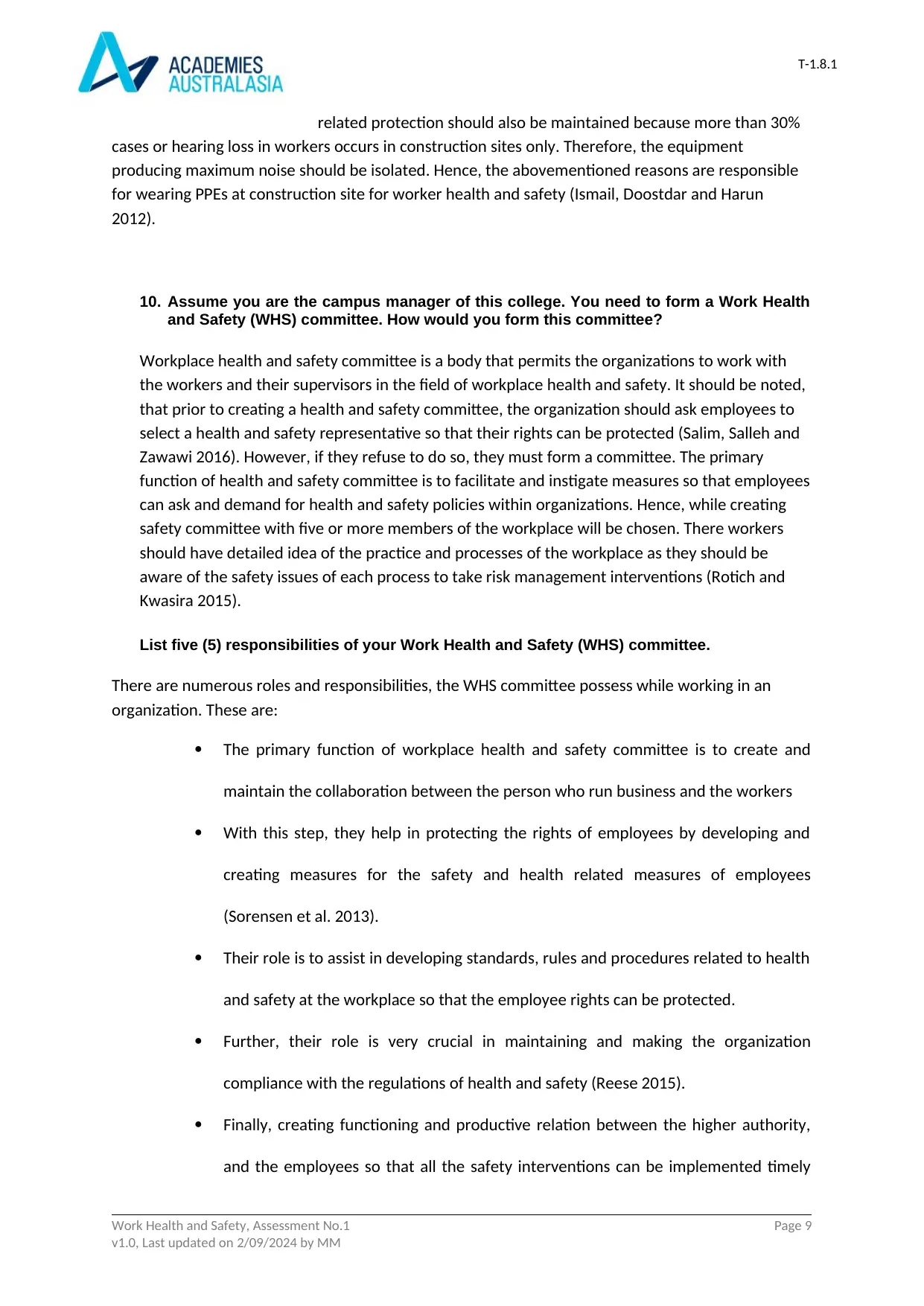
T-1.8.1
related protection should also be maintained because more than 30%
cases or hearing loss in workers occurs in construction sites only. Therefore, the equipment
producing maximum noise should be isolated. Hence, the abovementioned reasons are responsible
for wearing PPEs at construction site for worker health and safety (Ismail, Doostdar and Harun
2012).
10. Assume you are the campus manager of this college. You need to form a Work Health
and Safety (WHS) committee. How would you form this committee?
Workplace health and safety committee is a body that permits the organizations to work with
the workers and their supervisors in the field of workplace health and safety. It should be noted,
that prior to creating a health and safety committee, the organization should ask employees to
select a health and safety representative so that their rights can be protected (Salim, Salleh and
Zawawi 2016). However, if they refuse to do so, they must form a committee. The primary
function of health and safety committee is to facilitate and instigate measures so that employees
can ask and demand for health and safety policies within organizations. Hence, while creating
safety committee with five or more members of the workplace will be chosen. There workers
should have detailed idea of the practice and processes of the workplace as they should be
aware of the safety issues of each process to take risk management interventions (Rotich and
Kwasira 2015).
List five (5) responsibilities of your Work Health and Safety (WHS) committee.
There are numerous roles and responsibilities, the WHS committee possess while working in an
organization. These are:
The primary function of workplace health and safety committee is to create and
maintain the collaboration between the person who run business and the workers
With this step, they help in protecting the rights of employees by developing and
creating measures for the safety and health related measures of employees
(Sorensen et al. 2013).
Their role is to assist in developing standards, rules and procedures related to health
and safety at the workplace so that the employee rights can be protected.
Further, their role is very crucial in maintaining and making the organization
compliance with the regulations of health and safety (Reese 2015).
Finally, creating functioning and productive relation between the higher authority,
and the employees so that all the safety interventions can be implemented timely
Work Health and Safety, Assessment No.1 Page 9
v1.0, Last updated on 2/09/2024 by MM
related protection should also be maintained because more than 30%
cases or hearing loss in workers occurs in construction sites only. Therefore, the equipment
producing maximum noise should be isolated. Hence, the abovementioned reasons are responsible
for wearing PPEs at construction site for worker health and safety (Ismail, Doostdar and Harun
2012).
10. Assume you are the campus manager of this college. You need to form a Work Health
and Safety (WHS) committee. How would you form this committee?
Workplace health and safety committee is a body that permits the organizations to work with
the workers and their supervisors in the field of workplace health and safety. It should be noted,
that prior to creating a health and safety committee, the organization should ask employees to
select a health and safety representative so that their rights can be protected (Salim, Salleh and
Zawawi 2016). However, if they refuse to do so, they must form a committee. The primary
function of health and safety committee is to facilitate and instigate measures so that employees
can ask and demand for health and safety policies within organizations. Hence, while creating
safety committee with five or more members of the workplace will be chosen. There workers
should have detailed idea of the practice and processes of the workplace as they should be
aware of the safety issues of each process to take risk management interventions (Rotich and
Kwasira 2015).
List five (5) responsibilities of your Work Health and Safety (WHS) committee.
There are numerous roles and responsibilities, the WHS committee possess while working in an
organization. These are:
The primary function of workplace health and safety committee is to create and
maintain the collaboration between the person who run business and the workers
With this step, they help in protecting the rights of employees by developing and
creating measures for the safety and health related measures of employees
(Sorensen et al. 2013).
Their role is to assist in developing standards, rules and procedures related to health
and safety at the workplace so that the employee rights can be protected.
Further, their role is very crucial in maintaining and making the organization
compliance with the regulations of health and safety (Reese 2015).
Finally, creating functioning and productive relation between the higher authority,
and the employees so that all the safety interventions can be implemented timely
Work Health and Safety, Assessment No.1 Page 9
v1.0, Last updated on 2/09/2024 by MM
⊘ This is a preview!⊘
Do you want full access?
Subscribe today to unlock all pages.

Trusted by 1+ million students worldwide
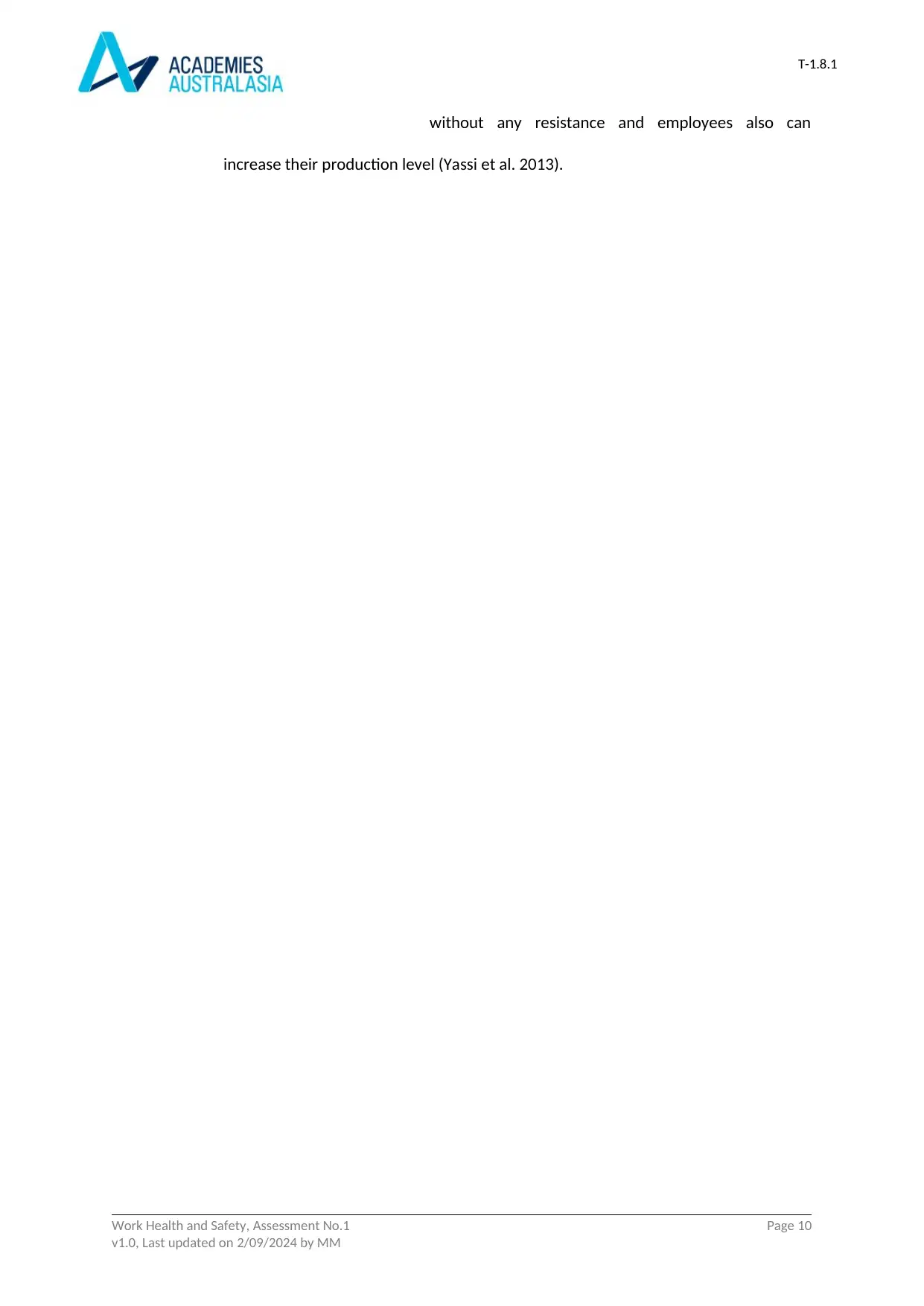
T-1.8.1
without any resistance and employees also can
increase their production level (Yassi et al. 2013).
Work Health and Safety, Assessment No.1 Page 10
v1.0, Last updated on 2/09/2024 by MM
without any resistance and employees also can
increase their production level (Yassi et al. 2013).
Work Health and Safety, Assessment No.1 Page 10
v1.0, Last updated on 2/09/2024 by MM
Paraphrase This Document
Need a fresh take? Get an instant paraphrase of this document with our AI Paraphraser
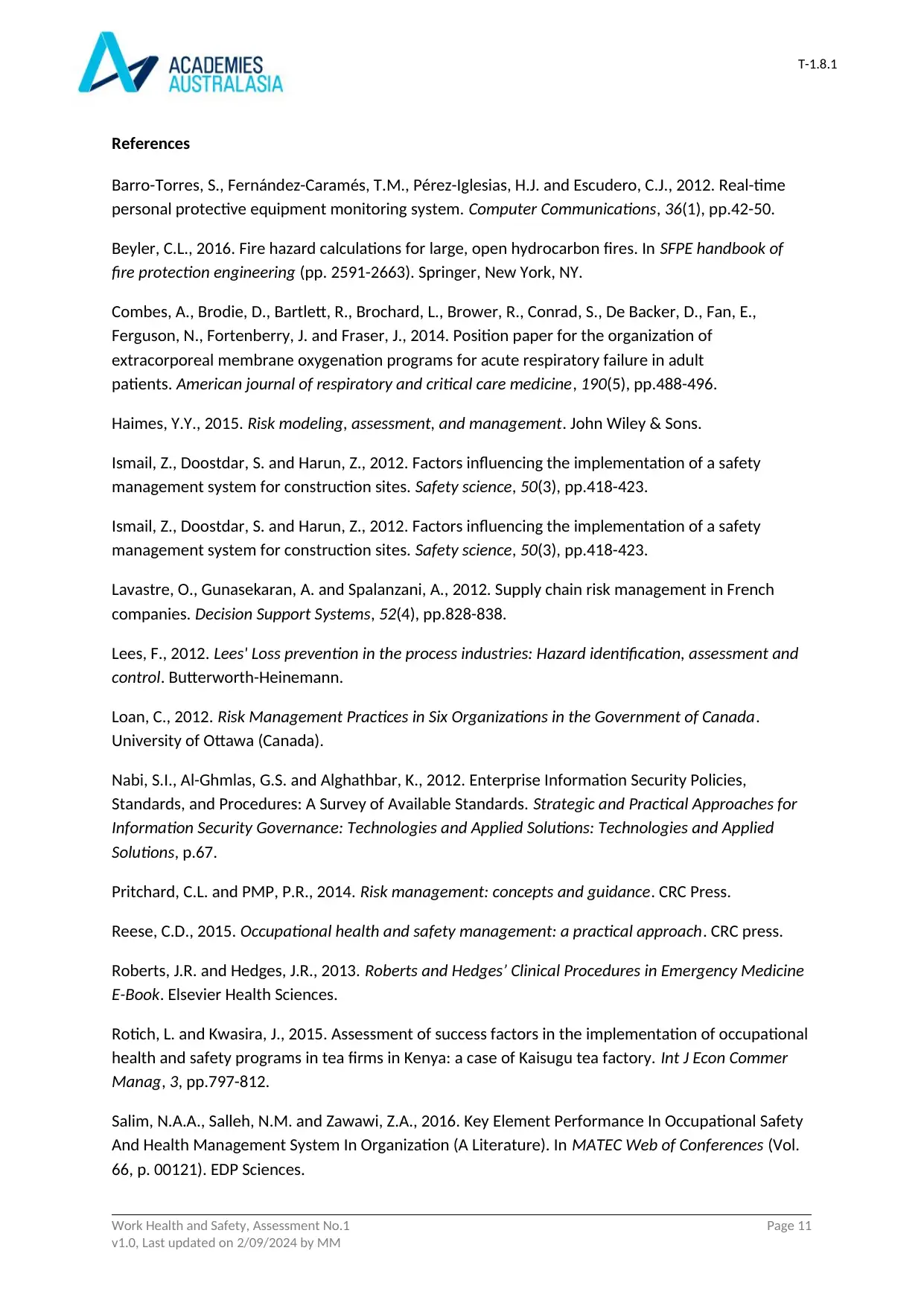
T-1.8.1
References
Barro-Torres, S., Fernández-Caramés, T.M., Pérez-Iglesias, H.J. and Escudero, C.J., 2012. Real-time
personal protective equipment monitoring system. Computer Communications, 36(1), pp.42-50.
Beyler, C.L., 2016. Fire hazard calculations for large, open hydrocarbon fires. In SFPE handbook of
fire protection engineering (pp. 2591-2663). Springer, New York, NY.
Combes, A., Brodie, D., Bartlett, R., Brochard, L., Brower, R., Conrad, S., De Backer, D., Fan, E.,
Ferguson, N., Fortenberry, J. and Fraser, J., 2014. Position paper for the organization of
extracorporeal membrane oxygenation programs for acute respiratory failure in adult
patients. American journal of respiratory and critical care medicine, 190(5), pp.488-496.
Haimes, Y.Y., 2015. Risk modeling, assessment, and management. John Wiley & Sons.
Ismail, Z., Doostdar, S. and Harun, Z., 2012. Factors influencing the implementation of a safety
management system for construction sites. Safety science, 50(3), pp.418-423.
Ismail, Z., Doostdar, S. and Harun, Z., 2012. Factors influencing the implementation of a safety
management system for construction sites. Safety science, 50(3), pp.418-423.
Lavastre, O., Gunasekaran, A. and Spalanzani, A., 2012. Supply chain risk management in French
companies. Decision Support Systems, 52(4), pp.828-838.
Lees, F., 2012. Lees' Loss prevention in the process industries: Hazard identification, assessment and
control. Butterworth-Heinemann.
Loan, C., 2012. Risk Management Practices in Six Organizations in the Government of Canada.
University of Ottawa (Canada).
Nabi, S.I., Al-Ghmlas, G.S. and Alghathbar, K., 2012. Enterprise Information Security Policies,
Standards, and Procedures: A Survey of Available Standards. Strategic and Practical Approaches for
Information Security Governance: Technologies and Applied Solutions: Technologies and Applied
Solutions, p.67.
Pritchard, C.L. and PMP, P.R., 2014. Risk management: concepts and guidance. CRC Press.
Reese, C.D., 2015. Occupational health and safety management: a practical approach. CRC press.
Roberts, J.R. and Hedges, J.R., 2013. Roberts and Hedges’ Clinical Procedures in Emergency Medicine
E-Book. Elsevier Health Sciences.
Rotich, L. and Kwasira, J., 2015. Assessment of success factors in the implementation of occupational
health and safety programs in tea firms in Kenya: a case of Kaisugu tea factory. Int J Econ Commer
Manag, 3, pp.797-812.
Salim, N.A.A., Salleh, N.M. and Zawawi, Z.A., 2016. Key Element Performance In Occupational Safety
And Health Management System In Organization (A Literature). In MATEC Web of Conferences (Vol.
66, p. 00121). EDP Sciences.
Work Health and Safety, Assessment No.1 Page 11
v1.0, Last updated on 2/09/2024 by MM
References
Barro-Torres, S., Fernández-Caramés, T.M., Pérez-Iglesias, H.J. and Escudero, C.J., 2012. Real-time
personal protective equipment monitoring system. Computer Communications, 36(1), pp.42-50.
Beyler, C.L., 2016. Fire hazard calculations for large, open hydrocarbon fires. In SFPE handbook of
fire protection engineering (pp. 2591-2663). Springer, New York, NY.
Combes, A., Brodie, D., Bartlett, R., Brochard, L., Brower, R., Conrad, S., De Backer, D., Fan, E.,
Ferguson, N., Fortenberry, J. and Fraser, J., 2014. Position paper for the organization of
extracorporeal membrane oxygenation programs for acute respiratory failure in adult
patients. American journal of respiratory and critical care medicine, 190(5), pp.488-496.
Haimes, Y.Y., 2015. Risk modeling, assessment, and management. John Wiley & Sons.
Ismail, Z., Doostdar, S. and Harun, Z., 2012. Factors influencing the implementation of a safety
management system for construction sites. Safety science, 50(3), pp.418-423.
Ismail, Z., Doostdar, S. and Harun, Z., 2012. Factors influencing the implementation of a safety
management system for construction sites. Safety science, 50(3), pp.418-423.
Lavastre, O., Gunasekaran, A. and Spalanzani, A., 2012. Supply chain risk management in French
companies. Decision Support Systems, 52(4), pp.828-838.
Lees, F., 2012. Lees' Loss prevention in the process industries: Hazard identification, assessment and
control. Butterworth-Heinemann.
Loan, C., 2012. Risk Management Practices in Six Organizations in the Government of Canada.
University of Ottawa (Canada).
Nabi, S.I., Al-Ghmlas, G.S. and Alghathbar, K., 2012. Enterprise Information Security Policies,
Standards, and Procedures: A Survey of Available Standards. Strategic and Practical Approaches for
Information Security Governance: Technologies and Applied Solutions: Technologies and Applied
Solutions, p.67.
Pritchard, C.L. and PMP, P.R., 2014. Risk management: concepts and guidance. CRC Press.
Reese, C.D., 2015. Occupational health and safety management: a practical approach. CRC press.
Roberts, J.R. and Hedges, J.R., 2013. Roberts and Hedges’ Clinical Procedures in Emergency Medicine
E-Book. Elsevier Health Sciences.
Rotich, L. and Kwasira, J., 2015. Assessment of success factors in the implementation of occupational
health and safety programs in tea firms in Kenya: a case of Kaisugu tea factory. Int J Econ Commer
Manag, 3, pp.797-812.
Salim, N.A.A., Salleh, N.M. and Zawawi, Z.A., 2016. Key Element Performance In Occupational Safety
And Health Management System In Organization (A Literature). In MATEC Web of Conferences (Vol.
66, p. 00121). EDP Sciences.
Work Health and Safety, Assessment No.1 Page 11
v1.0, Last updated on 2/09/2024 by MM
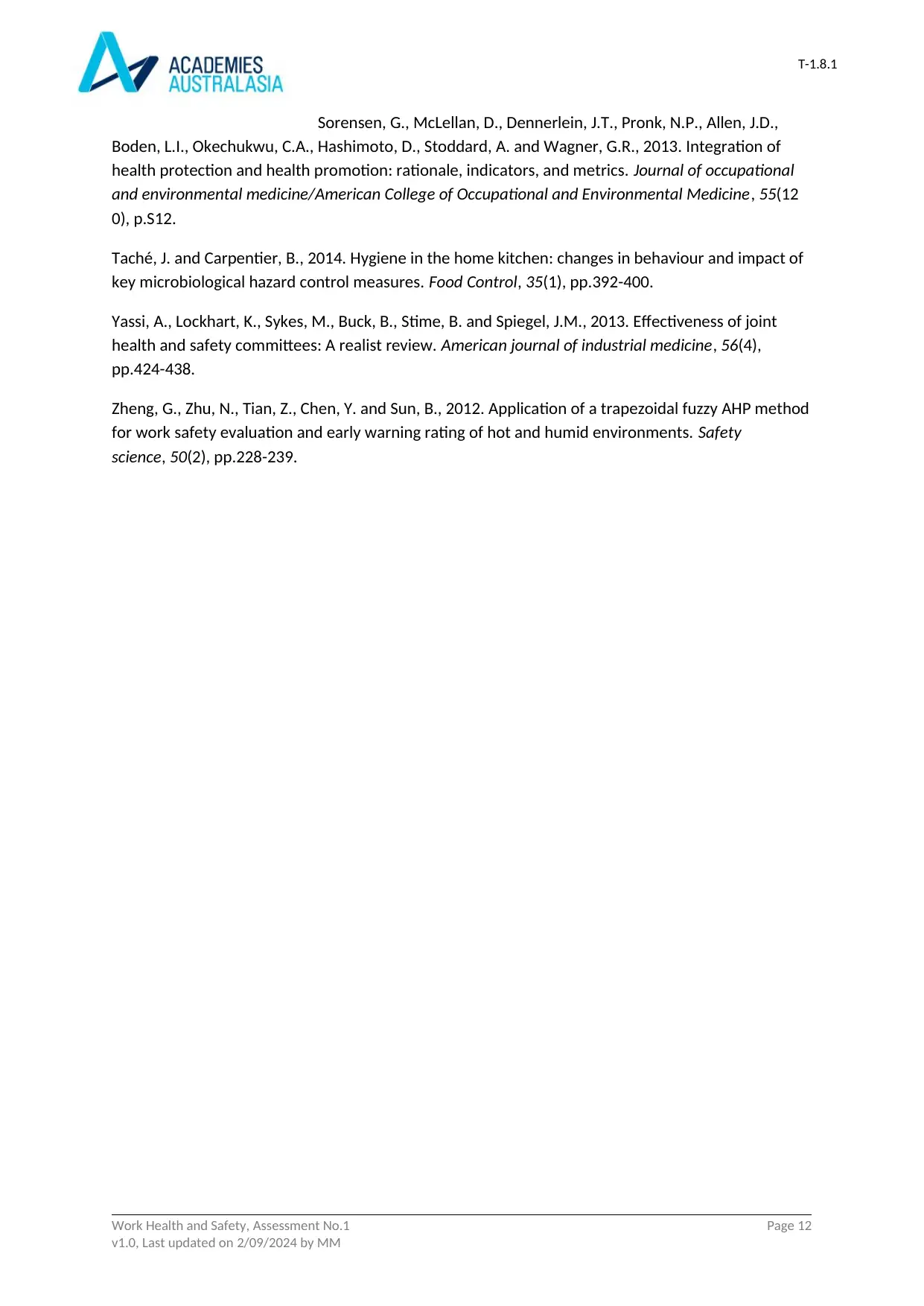
T-1.8.1
Sorensen, G., McLellan, D., Dennerlein, J.T., Pronk, N.P., Allen, J.D.,
Boden, L.I., Okechukwu, C.A., Hashimoto, D., Stoddard, A. and Wagner, G.R., 2013. Integration of
health protection and health promotion: rationale, indicators, and metrics. Journal of occupational
and environmental medicine/American College of Occupational and Environmental Medicine, 55(12
0), p.S12.
Taché, J. and Carpentier, B., 2014. Hygiene in the home kitchen: changes in behaviour and impact of
key microbiological hazard control measures. Food Control, 35(1), pp.392-400.
Yassi, A., Lockhart, K., Sykes, M., Buck, B., Stime, B. and Spiegel, J.M., 2013. Effectiveness of joint
health and safety committees: A realist review. American journal of industrial medicine, 56(4),
pp.424-438.
Zheng, G., Zhu, N., Tian, Z., Chen, Y. and Sun, B., 2012. Application of a trapezoidal fuzzy AHP method
for work safety evaluation and early warning rating of hot and humid environments. Safety
science, 50(2), pp.228-239.
Work Health and Safety, Assessment No.1 Page 12
v1.0, Last updated on 2/09/2024 by MM
Sorensen, G., McLellan, D., Dennerlein, J.T., Pronk, N.P., Allen, J.D.,
Boden, L.I., Okechukwu, C.A., Hashimoto, D., Stoddard, A. and Wagner, G.R., 2013. Integration of
health protection and health promotion: rationale, indicators, and metrics. Journal of occupational
and environmental medicine/American College of Occupational and Environmental Medicine, 55(12
0), p.S12.
Taché, J. and Carpentier, B., 2014. Hygiene in the home kitchen: changes in behaviour and impact of
key microbiological hazard control measures. Food Control, 35(1), pp.392-400.
Yassi, A., Lockhart, K., Sykes, M., Buck, B., Stime, B. and Spiegel, J.M., 2013. Effectiveness of joint
health and safety committees: A realist review. American journal of industrial medicine, 56(4),
pp.424-438.
Zheng, G., Zhu, N., Tian, Z., Chen, Y. and Sun, B., 2012. Application of a trapezoidal fuzzy AHP method
for work safety evaluation and early warning rating of hot and humid environments. Safety
science, 50(2), pp.228-239.
Work Health and Safety, Assessment No.1 Page 12
v1.0, Last updated on 2/09/2024 by MM
⊘ This is a preview!⊘
Do you want full access?
Subscribe today to unlock all pages.

Trusted by 1+ million students worldwide
1 out of 12
Related Documents
Your All-in-One AI-Powered Toolkit for Academic Success.
+13062052269
info@desklib.com
Available 24*7 on WhatsApp / Email
![[object Object]](/_next/static/media/star-bottom.7253800d.svg)
Unlock your academic potential
Copyright © 2020–2025 A2Z Services. All Rights Reserved. Developed and managed by ZUCOL.





